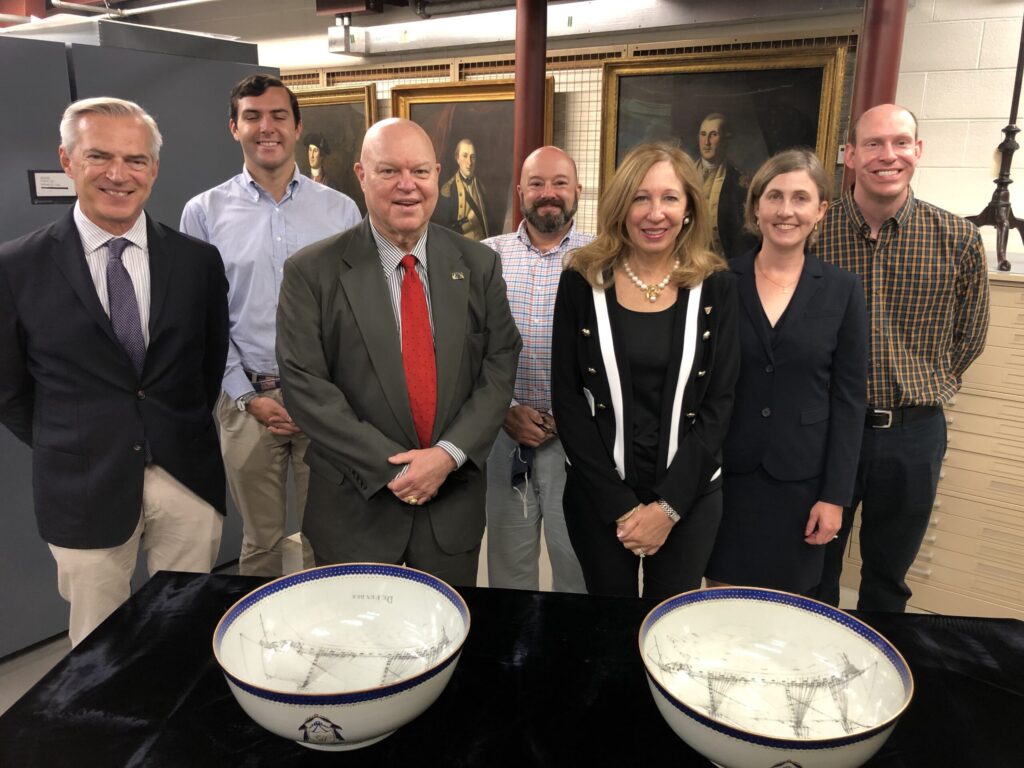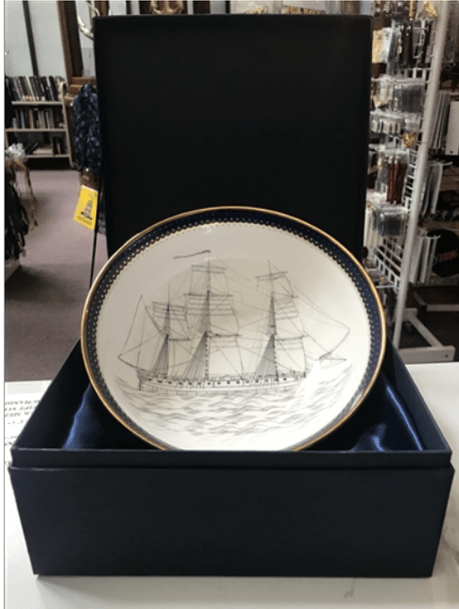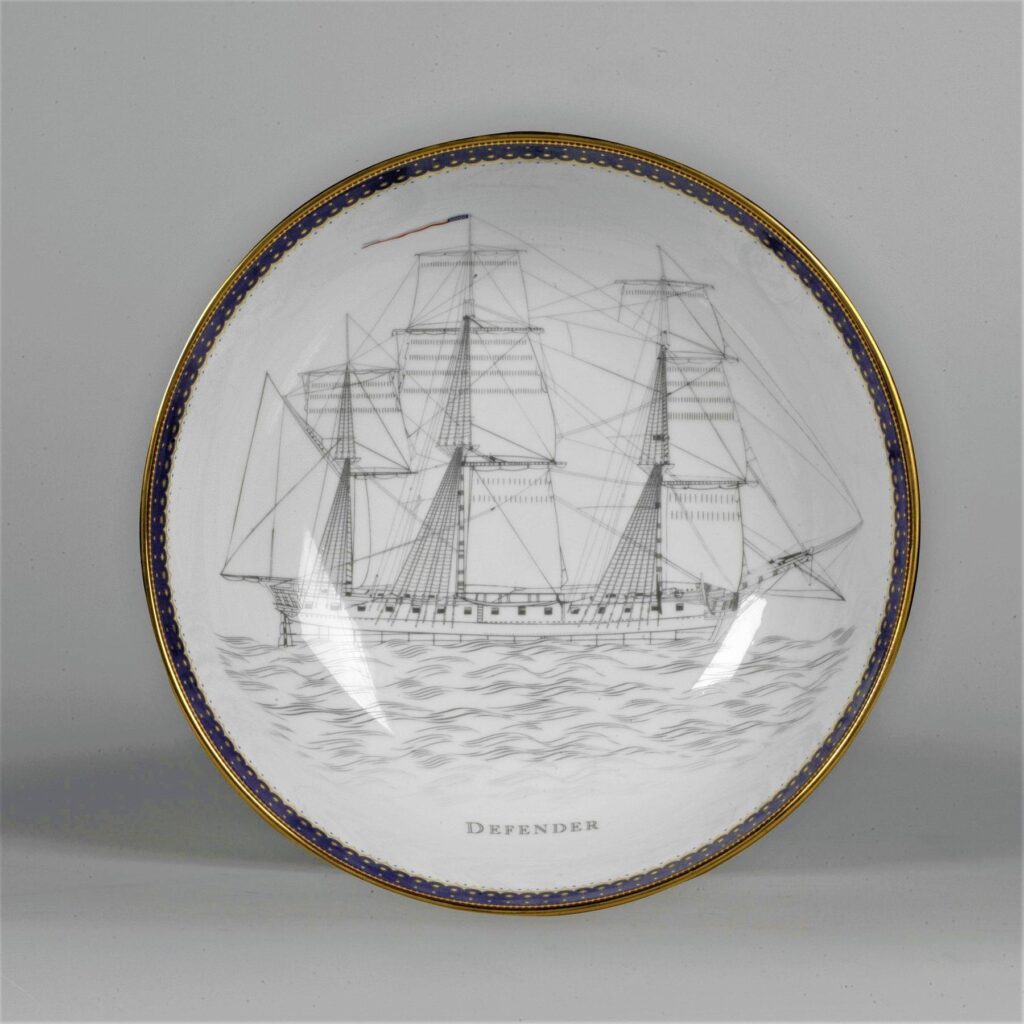
Mr. Kenneth Hill, Mount Vernon’s Development Division, Senior Major Gifts Officer; Mr. James Longley, 6th generation descendant of Commodore Thomas Truxtun; RADM Sonny Masso, Executive Director, Naval Historical Foundation; Mr. Mark Weber, Managing Director, National Museum of the U.S. Navy; Dr. Jennifer London; Ms. Amanda Isaac, Associate Curator at Mount Vernon; Mr. Wesley Schwenk, Collections Manager, NMUSN.
Friday, September 17, witnessed a small gathering at Mount Vernon’s collection storage facility to view and compare two Chinese porcelain punch bowls that were commissioned in the late 18th century by Revolutionary War privateer hero and post-war merchant ship captain, Commodore Thomas Truxtun. In the midst of overseeing construction of Constellation, one of the U.S. Navy’s first six frigates, in the 1795-1797 time frame, Truxtun ordered two large punch bowls featuring a detailed Chinese artist’s depiction of a 44-gun frigate rigged for war gracing the bowls’ interiors. The bowls were exact duplicates–except for the outside decorative cartouches featuring Truxtun’s stylized initials “TT” on one bowl and our first president George Washington’s “GW” on the other. In addition, the Washington Bowl has the word “Defender” added below the ship image, likely Truxtun’s tribute to Washington’s role as the Revolutionary War’s military victor.
While the details of how and when Truxtun presented the “Defender” bowl to Washington are lost to history, the bowl was at Mount Vernon by the time of Washington’s 1799 death. Truxtun’s bowl remained in his family through several generations, until one of the Commodore’s descendants gifted the “TT” bowl to the Naval Historical Foundation in the late 1940s. It was displayed in the Foundation’s downtown Washington, DC Truxtun-Decatur Museum and subsequently the Navy’s National Museum of the US Navy at the Washington Navy Yard, where it remains today.
The “GW” or “Defender” bowl had a more exciting journey through history. Bequeathed at her 1802 death as “the bowl with the ship in it” by Martha Washington to grandson George Washington Parke Custis. The bowl passed at his late 1850s death to his daughter Mary. Mary had married young U.S. Army officer Robert E. Lee in 1831 and their family was living at the Custis estate at the outbreak of the Civil War. When Mrs. Lee and family left for Richmond, Virginia after Virginia seceded and her husband resigned his U.S. Army commission, the bowl remained behind in the Lee residence, Arlington House, during the war. It went missing during the property’s occupation by Union Army troops, and emerged years later in New England. The Washington bowl returned to Mount Vernon in time for the 1976 Bicentennial.
In 1981 an NHF member and Truxtun descendant happened to visit Mount Vernon and noted the similarity with the bowl in the Navy Museum, and the bowls were briefly reunited for the first time. Close coordination between NHF, the Navy Museum and Mount Vernon facilitated this year’s reunion and opportunity to closely examine and compare the two bowls with modern technology. The gathering, attended by NHF, Mount Vernon and Navy Museum representatives and a 6th-generation Truxtun descendant, was entertained first by former NHF executive director Captain Todd Creekman who spoke about Truxtun’s merchant and naval career, his relationship with George Washington, and the production of the bowls; and then by Mount Vernon’s associate curator Amanda Isaac (daughter of Creekman and his wife Debbie) who described the odyssey of the “Defender” bowl and its eventual return to Mount Vernon. While tempted to mark the occasion by filling the bowls with a modern-day rendition of a traditional punch enjoyed by the Washington family, cooler heads prevailed and the attendees merely gazed at the side-by-side bowls, now reunited for only the second time since Truxtun received them from a China trading voyage nearly 225 years ago.



